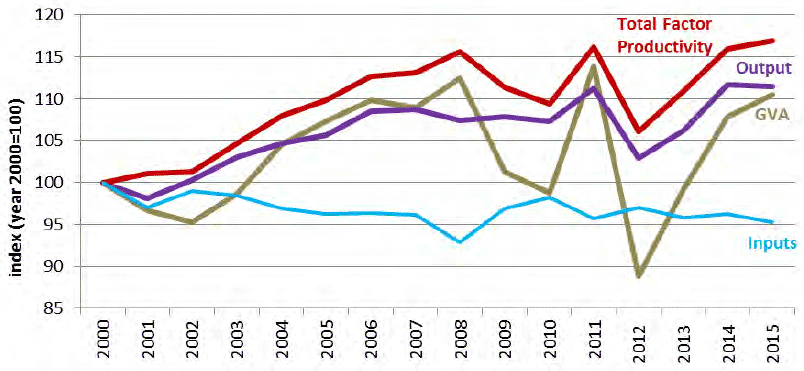Economic Report on Scottish Agriculture, 2016
Presents an overall picture of Scottish agriculture using data from the various agricultural surveys that RESAS manage.
3.8 Productivity indices (Table A16)
Table A16 (see also spreadsheet version online) shows six different productivity indices. To produce these, income and expenditure accounts (similar to TIFF) are calculated based on constant prices. The percentage annual changes in these is calculated, which are then converted into indices.
- The Output Index looks at how the volume of output changes over time. It doesn't take into account capital formation, and is not affected by whether commodities have received coupled support (a change to previously published data).
- The Input Index looks at most items of input, hence how the volume of input changes over time. It doesn't however take into account spend on contract work, interest or taxes on production.
- Total Factor Productivity Index calculates the ratio of outputs to inputs, in line with that published at UK-level by DEFRA. This has not previously been published and will replace Output per Unit Input.
- The Gross Value Added Index is a volume-based indicator of the economic size of the industry, used in GDP calculations. As with the other indicators, it is not, strictly speaking, affected by the value of commodities, other than in terms of the weight given to each element within the calculation. This index is therefore different from the Gross Value Added figure included in Table A1.
- The Output per Unit of Input Index (not shown on chart 3.11) is similar to Total Factor Productivity, but includes/excludes different items. It was published previously and we have included it this year to provide the updated time series.
- The Net Value Added per AWU Index (not shown on chart 3.11) includes output less most categories of costs, though not labour, rent or interest. It then calculates this per unit of labour. It was published previously and we have included it this year to provide the updated time series.
The five indicators, excluding Input, show fluctuating growth compared to the base year 2000. Initial growth until 2006 has stuttered, with dips in 2010 and 2012, resulting in the trend since 2006 struggling to show much increase. Chart 3.11 shows four of these indices. Please note that the methodology and data used for calculating these have changed since previous publications, resulting in considerably different results. See the online Annex to this publication for more details.
Chart 3.11: Productivity indices, 2000 to 2015

Contact
There is a problem
Thanks for your feedback